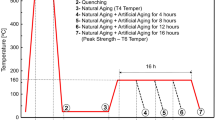Abstract
Investment casting has emerged as one of the most direct and desirable routes from liquid metal to parts of amazing complexity. Metallurgical developments since the late 1980s have enabled the design and manufacture of components used in static- and dynamic-loaded components. Foundry-process parameters used for such applications have been traditionally optimized with respect to static properties and governing mechanisms and are fairly well understood. The goal of this study is to evaluate how the combinations of process parameters that result either in maximum yield strength or maximum ductility also affect the fatigue life of components. The influence of some casting and heat-treatment parameters affecting microstructure (e.g., dendritic arm spacing, silicon-eutectic structure, and precipitation of age-hardening phases) is assessed on both the static tensile properties and fatigue life.
Similar content being viewed by others
References
S. Kennerknecht, “Design and Specification of Aluminum Airframe Structural Components,” (paper presented at Aeromat ’95, Anaheim, CA, 8–11 May 1995).
X. Dumant and S. Kennerknecht, “Conception et Development de Pieces Structurales Moulees en Fonderie Cire Perdue a Hautes Caracteristiques,” Ciral technical report (1996).
Fatigue and Fracture Properties of Aluminum Alloy Castings, Fatigue and Fracture, vol. 19 (Materials Park, OH: ASM, 1992).
“Microstructure Control In Hypoeutectic Aluminum-Silicon Alloys” (Philadelphia, PA: American Foundrymens Society, 1986).
P. Fournier, K-H Rendigs, and H. Frommeyer, “Statistical Investigations on A357 Sand and Investment Castings” (paper presented at Aeromat 95, Anaheim, CA, 8–11 May 1995).
C. Carre, “Caracterisation Apres Dissectiond Une Piece Obtenue par le Procede de cire Perdue,” report DCR/M-60063/F-93, Aerospatiale (France: Services Techniques des Programmes Aeronautiques).
M. Drouzy, S. Jacob, and M. Richard, AFS Int. Cast Metals Res. J., June (1980), pp 43–50.
S. Kennerknecht et al., “Commercial Development of D357 Alloy Investment Cast Aircraft Door Substructures” (paper presented at Aeromat ’96, Dayton, OH, 5 June, 1996).
M. Garat, “Effets Respectifs de la Finesse de Structure et de la Compacité sur les Caractéristiques Mécaniques Statiques et Dynamiques” report de l’A-S7G06 (357), Aluminum Pechiney.
Author information
Authors and Affiliations
Additional information
S. Kennerknecht earned his MBA at McGill University in 1986. He is currently vice president of technology at Cercast Group and general manager of Cercast.
X. Dumant earned his M. Eng. in metallurgy at Ecole Centrale de Paris, France, in 1984. He is currently technical director at Ciral, France.
R. Tombari earned his B. Eng. in metallurgy at McGill University in 1983. He is currently chief process engineer at Cercast, Canada.
P. Van Biljon earned his M. Eng. in metallurgy at University of Witwatersrand, Johannesburg, South Africa in 1985. He is currently process engineer at Cercon, Texas.
Rights and permissions
About this article
Cite this article
Kennerknecht, S., Dumant, X., Tombari, R. et al. The effect of processing parameters on the fatigue properties of D357 investment castings. JOM 49, 22–28 (1997). https://doi.org/10.1007/s11837-997-0007-6
Issue Date:
DOI: https://doi.org/10.1007/s11837-997-0007-6




